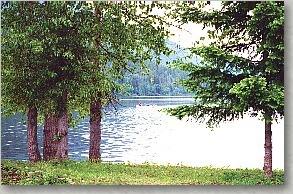Sight Fishing the Shallow Water
article by Peter at Fred's Custom Tackle

June is probably the most productive month for fly fishing the Merritt and Kamloops area lakes. Given normal weather, water temperatures are warm enough to bring good hatches in the shallows and shoals yet are not uncomfortable to fish. It is common to find good numbers of trout cruising the shallows at these times. These conditions can provide excellent opportunity for sight fishing these trout.
Sight fishing is best done from a boat as it offers a higher vantage and greater viewing area. The glare off the water is greatly reduced by using polarized glasses and a wide brim hat!
Areas close to a drop-off with cluster or patches of weeds on an otherwise clear bottom are the most easily fished. The clear sections make spotting the fish considerably easier as they stand out against the bottom. Cruising trout often travel close to the bottom searching the weed patches for shrimp, leeches, mayfly, sedge and dragonfly nymphs.
Anchoring in deep water just within casting range will help to reduce spooking the fish. After anchoring, allow the area to calm down before you start fishing. From a standing position, scan the area, if fish are "on the feed," they will show themselves within 15 minutes or so. Once you determine an active area you are ready to fish.
Using a floating fly line and a long leader (16 - 20') with fine tippet (#3) provides an almost spook free presentation.

Cast into the travelled area and allow your fly to sink to the bottom. Fly patters with hackle or fuzzy bodies which cover the hook point will reduce the chances of picking up weed upon retrieval. As an approaching fish gets within about 35' of your fly, begin your retrieve. The fly will be pulled up off the bottom and is almost always noticed. Once a fish makes a change in direction towards your fly do not stop or slow your retrieve. Often, gradually increasing the speed of retrieve can drive the fish to take the fly. Remain as still as possible as the fish closes in on your fly, do not set the hook by sight, wait until you feel the fish and then lift your rod tip and keep your line tight. Fish hooked in these shallows often take off in a burst of speed, so keep any loose line tidy and tangle free.
Fish that take pursuit of your fly but do not take, usually indicates that you are using too big a fly, too heavy a tippet or too short a leader.
Once you get the hang of it, sight fishing in the shallows is, next to dry fly fishing, the most exciting form of lake fly fishing.
Good Luck and Good Fishing.
| 



